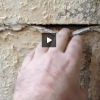Wall Cracks
Over time all concrete will crack, crumble and finally wash away. Wall cracks are a natural part of all poured concrete and block foundations. If a basement is situated far enough under ground and a crack develops it will leak water pretty easily. The methods of repairing wall cracks are few.
Epoxy
Probably the most damaging solution is to inject epoxy into the wall to fill the crack. The problem in doing this is that epoxy is hundreds of times harder than the concrete and injecting it into the wall only forces the wall farther apart. The epoxy also does not adhere to the concrete and with slight settlement/movement crack becomes larger and leaks more than before. Epoxy is the poorest and most damaging solution to repairing a wall crack. When epoxy is instead used to coat the wall and cover a crack the same principals apply. The epoxy does not adhere to the concrete, comes loose and leaks just as before.
Sealing The Crack From Outside
It is very common for some waterproofing contractors to consider trying to seal the crack from the outside of the wall. This can certainly work on two condition. That it is sealed correctly and that there is adequate drainage nearby. If there is not adequate drainage water will still sit on the sealed area and the water will eventually make its way through whatever sealant is applied. In the scientific community, water is called the universal solvent for a very good reason.
Vapor Barriers
Sealing from the outside usually involves using plastic vapor barriers on the wall. It is nearly impossible to get plastic sheeting to permanently to a concrete wall and what results is a half sealed bag of water on the foundation wall that now slowly leaks in to the basement after every rain.
Tar
Due to this some use tar instead. The problem with tar is that over time it tends to get brittle. As the crack moves the tar crack open and leaks as before.
Drainage and Vapor Barrier
Best solution outside is if there is adequate drainage away from the building. This allows you to run exterior drainage pipe to a lower portion of land and prevent the water form standing outside the wall crack. Then apply a vapor barrier on the inside of the wall where it is farther away from the elements and where it can be more easily inspected from time to time.
Interior drainage
Catching and redirecting the water from the inside is no doubt the surest way to guarantee a solution but it may be too invasive for some situations where the work could be performed jsut as well outside. This is almost on ly the case when the wall is not but a few feet underground. If the wall is very deep it is always better to install an interior system that utilizes a subfloor sump pump system.

